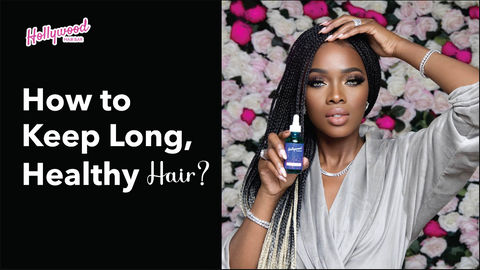How to Keep Long, Healthy Hair: 13 Essential Tips

Achieving and maintaining long, healthy hair requires dedication to a comprehensive hair care routine. Genetics certainly play a role, but with proper care and attention, anyone can enhance the quality and length of their hair. Let's delve into each essential tip to help you achieve your hair goals effectively.
Step 1: Wash Your Hair Less Often
Frequent washing can strip your hair of its natural oils, leaving it dry, brittle, and prone to breakage. Instead of washing daily, aim for 2-3 times a week, adjusting based on your hair type and lifestyle. Choose a sulfate-free shampoo that cleanses gently without harsh chemicals. Focus on massaging the shampoo into your scalp to remove dirt and excess oil while letting the suds clean the length of your hair as they rinse out.
Step 2: Apply Conditioner Properly
Conditioner is crucial for maintaining moisture and preventing tangles. Apply a generous amount to the mid-lengths and ends of your hair, where it tends to be drier. Avoid the scalp area to prevent weighing down your roots and causing greasiness. Leave the conditioner on for a few minutes to allow it to penetrate the hair shaft before rinsing thoroughly with cool water to seal the cuticle and enhance shine.
Step 3: Use a Hair Mask Weekly or As Needed
Hair masks provide intensive hydration and repair damaged hair. Choose a mask formulated for your hair type and concerns, whether it's for deep conditioning, repairing split ends, or adding shine. Apply the mask from root to tip after shampooing, focusing on the ends where hair is oldest and most prone to damage. Leave it on for the recommended time (usually 10-20 minutes), then rinse thoroughly. For extra pampering, consider using a warm towel or shower cap to help the mask penetrate deeply into the hair shaft.
Step 4: Protect Hair When Heat Styling
Heat styling tools like hair dryers, flat irons, and curling wands can damage hair, causing dryness, breakage, and split ends. Before using heat tools, apply a heat protectant spray or serum to shield your hair from high temperatures. Use the lowest effective heat setting and limit heat styling to minimize damage. Consider air-drying your hair whenever possible to reduce exposure to heat.
Step 5: Minimize Hair Processing
Chemical treatments such as hair dyes, perms, and relaxers can weaken hair and alter its natural structure. If you choose to color or chemically treat your hair, opt for professional services and follow up with deep conditioning treatments to restore moisture and strength. Consider less damaging alternatives like ammonia-free dyes or semi-permanent colors that fade gradually.
Step 6: Protect Hair from Sun and Swimming
UV rays from the sun and chlorine from swimming pools can damage hair, causing dryness and discoloration. Wear a wide-brimmed hat or use hair products containing UV filters when spending time outdoors. Before swimming, wet your hair with clean water to reduce chlorine absorption, and rinse it thoroughly after swimming to remove chlorine and saltwater residue.
Step 7: Detangle Hair Before Showering
Wet hair is more prone to breakage, so gently detangle it before shampooing to minimize damage. Use a wide-tooth comb or your fingers to work through knots, starting from the ends and working your way up to the roots. Apply a detangling spray or leave-in conditioner to help smooth out stubborn tangles without causing breakage.
Step 8: Brush Your Hair When Dry
Wet hair is fragile and more susceptible to damage, so wait until your hair is completely dry before brushing it. Use a wide-tooth comb or a brush designed for your hair type to gently work through knots and tangles. Start brushing from the ends and gradually move upwards to prevent pulling and breakage.
Step 9: Squeeze Wet Hair with a Towel
After washing your hair, avoid rubbing it vigorously with a towel, as this can cause friction and lead to breakage. Instead, gently squeeze excess water from your hair using a soft towel or an old t-shirt. Pat your hair dry rather than rubbing it to maintain its natural texture and minimize frizz.
Step 10: Protect and Moisturize Your Scalp
A healthy scalp is the foundation for healthy hair growth. Keep your scalp hydrated and nourished by using scalp treatments or massaging it with essential oils like jojoba or coconut oil. Scalp massages help stimulate blood circulation, promoting hair growth and maintaining overall scalp health.
Step 11: Care for Your Hair While You Sleep
Protect your hair while sleeping by using a silk or satin pillowcase, which reduces friction and minimizes tangles and breakage. Alternatively, loosely braid your hair or secure it in a loose bun to prevent it from rubbing against rough pillowcases and bedding.
Step 12: Get Regular Haircuts
Regular trims every 8-12 weeks help maintain healthy hair by preventing split ends and breakage. Even if you're growing your hair long, trimming the ends removes damaged hair and encourages healthier growth from the roots. Consult with your hairstylist to determine the best haircut schedule based on your hair's condition and growth goals.
Step 13: Eat a Healthy Diet and Drink Plenty of Water
Nutrition plays a vital role in hair health. Eat a balanced diet rich in vitamins, minerals, and proteins to support strong, healthy hair growth. Include foods like leafy greens, lean proteins, nuts, seeds, and whole grains in your diet. Stay hydrated by drinking plenty of water throughout the day to keep your scalp and hair follicles hydrated from within.
Final Words
By integrating these 13 essential tips into your hair care routine, you can nurture long, healthy hair that radiates vitality and strength. Remember, consistency and patience are key when it comes to achieving your hair goals. Tailor these tips to fit your hair type and lifestyle, and enjoy the journey to beautiful, healthy hair! Also you can Hollywood Hair Bar for organic hair products like Hair Regrowth Serum, Hair Rice Water, Hair Regrowth Tea and Honey Moisturizer that keeps your hair healthy and long.














